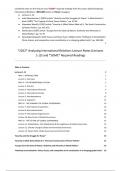Combined notes on the lectures and *SOME* required readings from the course (2022) Analysing
International Relations. INCLUDES notes on (Total: 61 pages):
● Lectures 1-13.
● John Mearsheimer’s (2001) article “Anarchy and the Struggle for Power” in Mearsheimer’s
book (1990) “The Tragedy of Great Power Politics.”, pp. 29-54.
● Alexander Wendt’s (1992) article “Anarchy Is What States Make of It: The Social Construction
of Power Politics”, pp. 391-425.
● David Lake’s (2007) article “Escape from the State of Nature: Authority and Hierarchy in
World Politics”, pp. 47-79.
● Kazushige Kobayashi, Keith Krause and Xinyu Yuan’s (2022) article “Pathways to Socialization:
China, Russia, and competitive norm socialization in a changing global order”, pp. 560-582.
1
*2022* Analyzing International Relations Lecture Notes (Lectures
1-13) and *SOME* Required Readings
Table of Contents
Lectures 1-13 2
PART I - INTRODUCTION 2
Lecture 1: Overview 2
PART II - THE INTERNATIONAL SYSTEM 2
Lecture 2: Anarchy 2
Lecture 3: International Hierarchy 4
Lecture 4: International Society 8
Lecture 5: Interdependence 12
Lecture 6: Capitalism 15
PART III - THE DYNAMICS OF GLOBAL GOVERNANCE 19
Lecture 7: International Cooperation 19
Lecture 8: International Rules 23
Lecture 9: International Organisations 28
Lecture 10: New Forms of Global Governance 31
PART IV - THE FUTURE OF GLOBAL GOVERNANCE 35
Lecture 11: Globalisation, Anti-Globalisation & the Legitimacy of Global Governance 35
Lecture 12: Climate Change & Global Environmental Governance 38
Lecture 13: Power Shifts, Global Governance & the Risk of War 42
“Anarchy and the Struggle for Power” 47
“Anarchy Is What States Make of It: The Social Construction of Power Politics” 51
“Escape from the State of Nature: Authority and Hierarchy in World Politics” 55
“Pathways to Socialization: China, Russia, and competitive norm socialization in a changing global order” 58
, 2
Lectures 1-13
PART I - INTRODUCTION
Lecture 1: Overview
Introduction to AIR
Big C’s = interconnected:
● Competition among great powers (US, Russia, China).
➔ USSR was NEVER a comprehensive power (economy, politics).
➔ US’s position is coming to an end.
● Contestation (challenge) of foundational ideas & institutions (e.g., US, UN).
➔ Fundamental concepts & processes are being contested.
● Conflict.
➔ Ukraine’s war has shaken the current understanding of the elimination of wars
between states.
➔ Challenges the assumption = civil/ethnic wars still exist, BUT major wars between
major states have been eliminated from international politics (a thing of the past).
● Extensive international cooperation.
➔ States cooperate a great deal (e.g., Ukraine & Russia still cooperating simultaneously,
despite the war).
● Climate change = biggest international/existential issue.
General tips/overview:
● Think beyond the headlines.
● Think critically about IR → be sceptical of official explanations & mass beliefs.
● Theories = tools NOT truths → compare answers to important questions.
● IR theories evolve, new ones emerge BUT they do NOT become obsolete over time.
● Focus on explanation = why, under what conditions?
○ Slight description = what, how, when, where?
○ Avoid prescription = what is right, fair, or desirable?
PART II - THE INTERNATIONAL SYSTEM
Lecture 2: Anarchy
Questions on readings:
In what way(s) can the international system be understood as anarchy, and what does this suggest about
international relations?
● Disagreement between Wendt & Mearsheimer on the ways anarchy works (implications), BUT
agree that the international system = anarchic.
, 3
International System
Many types of ‘actors’, BUT they do NOT float freely (e.g., states, sub-national bodies,
inter-governmental organisations, NGOs, MNCs, transnational networks).
➔ Coexist within a larger system that structures them.
➔ World is divided into territorial states.
System: A set of things connected to form a complex unity → a whole composed of parts ordered
according to some plan.
International System: A set of incentives/expectations shaping the identities & behaviours of states &
other actors in international politics.
➔ IMPORTANCE = has effects that CANNOT be explained simply by examining the
actors/organisations themselves.
➔ Multiple concepts:
1. Anarchy
2. Hierarchy
3. Society
4. Interdependence
5. Capitalism
Anarchy
Anarchy: The absence of effective central authority. Anarchy + order may co-exist.
➔ International Anarchy: The absence of effective central authority above states & other actors.
◆ “There is no government above governments” (Mearsheimer, 2001).
‘Billiard ball’ model of IR = states are like balls bouncing into each other. What’s inside the ball (state)
does NOT matter (Mearsheimer).
Kenneth Waltz’s (1979) “Theory of International Politics”:
● International system has 3 dimensions:
1. Ordering principle = anarchy.
2. Function of actors = alike (all states seek to survive).
3. Distribution of power = varies across actors.
● Anarchy → states are insecure → all rely on self-help to survive.
➔ Key variable = distribution of power among states.
◆ State’s relative power determines its interests.
◆ # of great powers (polarity) determines international alliances + risk of war.
● Anarchic systems differ in polarity:
○ Unipolar: 1 power, very rare, as states will create alliances to balance against the
single power → maximum certainty, clear leadership, domination.
○ Bipolar: 2 great powers, each with smaller alliances → high certainty, competition
for leadership, domination within alliances.
○ Multipolar: 3-5 great powers with shifting alliances (each other & smaller powers)
→ low certainty, risk of leadership vacuum, less risk of domination.





